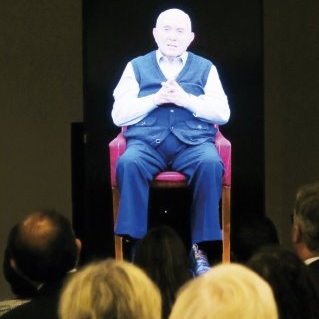click to dowload our latest edition
CLICK HERE TO SUBSCRIBE TO OUR NEWSLETTER


Published
5 years agoon
By
adminTALI FEINBERG
At the 20th anniversary celebration of the Cape Town Holocaust & Genocide Centre (CTHGC), audience members had a chance to speak to survivor Pinchas Gutter, who responded in kind. The questions ranged from “Tell us about your liberation.” to “How did your children respond to you being a Holocaust survivor?”
But Gutter wasn’t there in person. A holographic image of him answered instead. Ultimately, it was a chance to look into the future, and how we will interact with survivors long after they have passed away.
The executive director of the USC Shoah Foundation and keynote speaker, Dr Stephen Smith, played a key role in the birth of the Cape Town Holocaust Centre (as it was called then) in 1999, and now 20 years later, he returned to the Cape to look back at what has been achieved, and what could be possible in the future.
“We have 55 000 testimonies at the USC Shoah Foundation, and if we listened to them without stopping, it would take us 13 and a half years. It is a treasure of history and humanity, but it doesn’t necessarily answer our questions,” said Smith. “That’s why we’ve developed this project called ‘New Dimensions in Testimony’ which allows almost any audience to ask almost any question to a Holocaust survivor, even if they are no longer alive.”
Smith met Gutter when he interviewed him in South Africa, and the two formed a close connection. “He was the only person I could think of who would trust me with this process, which entailed answering 1 000 questions for 25 hours over five days, with 116 cameras, and 85 LED lights around him. At 85 years old, after all he has been through, this was no easy feat.”
But Gutter, who now lives in Canada, was up to the task. It was physically draining and mentally exhausting, but no question was too simple or off-limits. And so, the world now has a way of asking him almost anything.
In the demonstration, Smith asked Gutter if he believed in G-d, if he wanted revenge, and why the Jews “went like lambs to the slaughter”, all questions that a school child or adult might want to ask in the future. Gutter gave rich and eloquent answers, showing a full range of emotions, and it was hard to believe he was not really there in the room.
Since this groundbreaking interview, the USC Shoah Foundation has captured the testimony of 20 more Holocaust survivors this way. “Survivors have always used media to share their stories,” said Smith, referring to a woman in Bergen-Belsen talking to a camera after the camp had been liberated, with corpses piled behind her.
“It was probably the first audiovisual recording of a Holocaust survivor,” he says, adding that the woman who was recorded was terrified she would be shot by former SS guards nearby. “She said she thought she was going to die, but it would be worth it. Because giving testimony comes at a cost, but it is a risk one must take. Giving testimony is an act of resistance against the Nazis’ aim of wiping out all memory that Jews existed.”
Turning back to the holographic interviews, Smith pointed out that this was not just “technology for technology’s sake”, but a very practical response to that urgent question of how we will talk to eyewitnesses of the Holocaust in the future.
He explained that while the technology looks effortless, it is important to remember that it is both artificial and “not always very intelligent!” For example, Gutter’s hologram got confused about a question about apartheid, as he had never been asked it before.
Back at the USC Shoah Foundation, each answer is rated, and if it is not perfect, it is worked on. He explained that the computer accesses text of Gutter’s 25 hours of testimony, then works out what the best response would be based on keywords, but sometimes it gets it wrong.
Smith has worked with Gutter on a number of projects using new technology. When the survivor told Smith that he could not remember his twin sister who was killed in the camps, they travelled there to help him to recall her.
At the Majdanek death camp, they re-created the moment where Gutter lost contact with his father. This was turned into virtual reality, so that people who visit these places will be able to experience moments like these in real time. These projects are a work in progress, but offer a glimpse into what is possible.
Smith also paid tribute to the work of the CTHGC over the past 20 years. Founded by the visionary Myra Osrin, it was the first Holocaust Centre founded on the African continent at a time when the country was going through the post-apartheid reconciliation process.
“I wasn’t sure if it was the right time, but after speaking to people across the country, it was clear that it was needed then. And now, with so much violence in the world, these educational institutions are needed even more urgently.”
With 119 991 school pupils having gone through their exhibition and education programme over the last 20 years,, 25 000 local and international visitors per annum, and thousands of teachers trained around the country, it really is just the beginning of what this vital institution can do, now and into the future.
